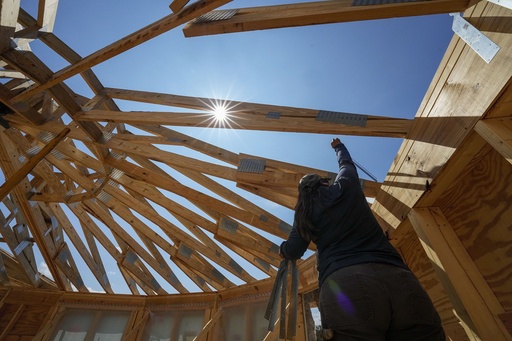
LOS ANGELES — The outlook for mortgage rates is becoming increasingly uncertain following Donald Trump’s election victory, even before he officially returns to the presidency. Trump has campaigned with promises to make home buying more accessible by reducing mortgage rates through measures designed to combat inflation. However, some economists and analysts warn that his anticipated economic policies might actually lead to higher mortgage rates.
The fluctuations in mortgage rates are driven by various factors, most notably the yield on U.S. 10-year Treasury bonds, which lenders utilize to set the prices for home loans. Recently, Treasury yields have increased despite the Federal Reserve’s decision to lower its benchmark interest rate, which typically affects all kinds of loans, including mortgages. This rise in yield suggests that investors are skeptical about the Fed’s approach to rate cuts, especially considering the strength of the economy.
Following Trump’s election victory, yields rose sharply, pushing the average rate for a 30-year mortgage up to 6.79%, as reported by Freddie Mac, a key player in the mortgage market. Danielle Hale, the chief economist at Realtor.com, commented, “The bond markets indicate that investors are preparing for higher rates under a Trump administration. This anticipation is likely to contribute to an increase in mortgage rates as well.”
Trump’s proposed economic strategies include imposing tariffs on imported goods, reducing tax rates, and easing regulatory measures. While these initiatives could stimulate economic growth, they may also lead to increased inflation and a rise in U.S. government debt—which, some economists believe, could contribute to higher interest rates and subsequently escalate mortgage rates.
Lisa Sturtevant, chief economist at Bright MLS, cautioned that Trump’s fiscal policies could lead to more volatile mortgage rates throughout the remainder of this year and into 2025. She estimates that the average rate for a 30-year loan is unlikely to fall below 6% next year.
Analysts from Raymond James and Associates have suggested that mortgage rates will likely remain “higher for longer,” particularly considering the recent election outcomes. They observed that first-time homebuyers may encounter even greater challenges regarding affordability in the upcoming spring season, which is traditionally a peak period for home sales.
Increased mortgage rates can lead to significant monthly expenses for borrowers, diminishing their purchasing power, especially as home prices continue to stay near record levels despite a prolonged downturn in housing market sales that began in 2022. The high rates, coupled with soaring prices, have made homeownership elusive for many first-time buyers. Data from the National Association of Realtors indicates these buyers represented only 24% of homes sold from July 2023 to June of the following year—a record low dating back to 1981; before the 2008 crisis, the share was around 40%.
As potential buyers find themselves priced out of homeownership or forced to postpone purchasing homes, they risk losing out on the wealth-building benefits that come with home equity appreciation. Current homeowners might also hesitate to sell; although the average rate on a 30-year mortgage has decreased from a 23-year high of nearly 8% last year, it remains prohibitively high for many potential sellers. According to Realtor.com, over 80% of homeowners with a mortgage enjoy an existing rate below 6%.
The recent uptick in bond yields appears to reflect investor expectations that Trump’s fiscal policies would amplify the federal deficit and spur inflation. The nonpartisan Committee for a Responsible Federal Budget estimates that his proposals could increase the federal budget deficit by $7.75 trillion over the next decade. To manage the interest connected to that debt, the government may need to issue more bonds, which could lead to higher yields and, consequently, elevated mortgage rates.
If inflation rates surge again, the Federal Reserve might halt the rate cuts initiated in September. Although inflation has already decreased from a peak of 9.1% in 2022 to a three-and-a-half-year low of 2.4%, much of this decline has been attributed to the Fed raising rates to unprecedented levels in recent decades.
While the central bank does not directly dictate mortgage rates, its policies and inflation trends have a meaningful impact on the 10-year Treasury yield. The Fed’s strategy is expected to eventually facilitate a decline in mortgage rates, but this trajectory could be altered if the incoming administration’s policies reignite inflation.
Hale noted, “There is still a prevailing hope that mortgage rates might decrease, but policy actions will play a major role.” Predicting the future of mortgage rates is complicated, as they are subject to a variety of influences, including government spending, economic conditions, and geopolitical tensions, as well as fluctuations in the stock and bond markets.
Prior to the recent elections, many housing economists anticipated the average rate on a 30-year mortgage would decline to around 6% by the end of this year, with additional decreases expected next year. Currently, experts from the Mortgage Bankers Association and Realtor.com believe the average rate will stabilize around 6%, while analysts from First American suggest a possible but uncertain decline towards that figure. Redfin’s head of economic research, Chen Zhao, expressed skepticism, stating, “It’s difficult to envision mortgage rates dropping below 6% next year unless we face a recession.”
The National Association of Realtors predicts that the average mortgage rate during Trump’s second term would hover between 5.5% and 6.5%. Lawrence Yun, NAR’s chief economist, emphasizes that a feasible strategy to reduce the budget deficit could help diminish mortgage rates.
That said, a return to the historically low rates observed during Trump’s initial term—ranging from a record low of 2.65% to 4.94%—is unlikely. The drop in rates during his first term was largely fueled by the economic disruptions caused by the COVID-19 pandemic, which prompted many investors to favor U.S. government bonds, thus driving their yields lower.
